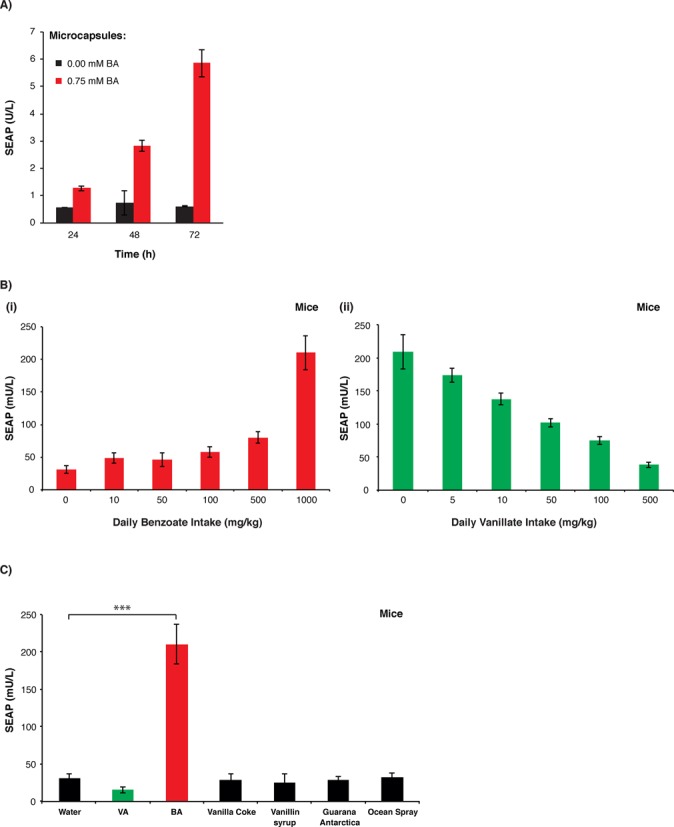Figure 4.

Benzoate-inducible transgene expression in mice. (A) SEAP induction profiles of microencapsulated CTS1/PCTS-O3P2-transgenic HeLa cells in vitro. In total, 2 × 106 pMX34/pMX42-transgenic microencapsulated HeLa cells (10 000 capsules, 200 cells/capsule) were cultivated per well of a 6-well plate containing 3 ml of standard medium with or without 0.75 mM sodium benzoate. SEAP expression was profiled in the culture supernatant every 24 h. The data are shown as the mean ± SD, n = 3. (B) Antagonistic dual-input control of the CTS1/PCTS-O3P2in vivo. In total, 2 × 106 pMX34/pMX42-transgenic microencapsulated HeLa cells (10 000 capsules, 200 cells/capsule) were intraperitoneally implanted into mice. (i) Treated mice drank 4 × 200 μl H2O containing different concentrations of sodium benzoate (total daily intake: 0–1000 mg/kg). (ii) Treated mice drank 4 × 200 μl sodium benzoate-containing H2O (total daily intake: 1000 mg/kg) and received (2 × 100 μl) different concentrations of vanillic acid concentrations (total daily intake: 0–500 mg/kg). The SEAP levels in the bloodstream of the treated animals were profiled after 24 h. The data are shown as the mean ± SEM, n = 8 mice. (C) Insensitivity of the CTS1/PCTS-O3P2-device to dietary intake of standard benzoate- and vanillate-containing food. In total, 2 × 106 pMX34/pMX42-transgenic microencapsulated HeLa cells (10 000 capsules, 200 cells/capsule) were intraperitoneally implanted into mice that drank 4 × 200 μl of either commercial soft drinks such as Guarana Antarctica, Ocean Spray cranberry juice or Vanilla Coke®, or a custom-made vanillin syrup (260 g/l of vanillin). Control mice either drank 4 × 200 μl sodium benzoate-containing H2O (total daily intake: 1000 mg/kg) or received (2 × 100 μl) of vanillic acid (total daily intake: 500 mg/kg). The SEAP levels in the bloodstreams of the treated animals were profiled after 24 h. The data are shown as the mean ± SEM; statistics by two-tailed t-test; n = 6 mice. ***P < 0.001 versus control.
